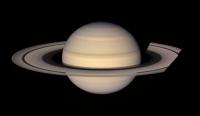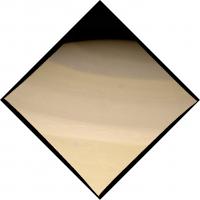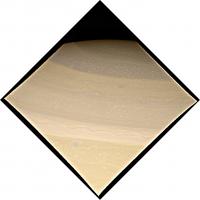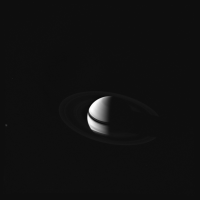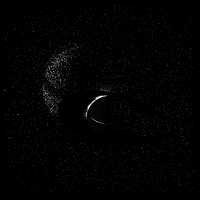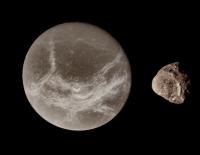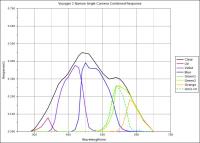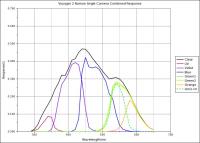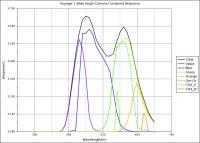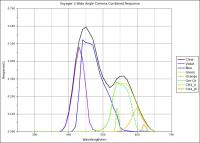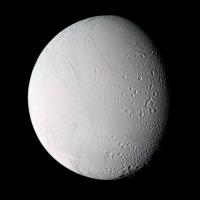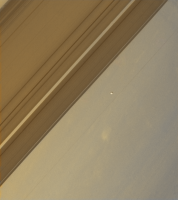Printable Version of Topic
Click here to view this topic in its original format
Unmanned Spaceflight.com _ Saturn _ Voyager 2 Saturn Revisited
Posted by: Bjorn Jonsson Jan 20 2007, 02:36 AM
Emily recently http://www.planetary.org/blog/article/00000813/ the availability of calibrated and geometrically corrected Voyager images. Actually I had 'discovered' this dataset several months earlier but then managed to completely forget about it. Now I decided to do something so I downloaded volume 37 and decided to do some quick-and-dirty processing, mainly to check if it was feasible to do a very high resolution map (probably 25 degrees/pixel to match my Cassini map of the southern hemisphere) of Saturn's entire northern hemisphere by colorizing green filtered images using lower resolution color data I processed several years ago - at the resolution I want only green filtered images are available.
This was successful, opening the door to a new 'monster project': A very high resolution full color map of Saturn's entire northern hemisphere.
First a color composite made from wide angle orange, green and blue images:
This one was made from images C4386547_GEOMED.IMG, C4386554_GEOMED.IMG and C4386608_GEOMED.IMG. I adjusted the color to something more realistic than I initially got and removed some reseau marks in Photoshop that were visible, especially near ring edges and Saturn's limb. Some color fringing was also visible on Saturn's disk due to Saturn's rotation while the three images were obtained; I removed this by cloning the color of adjacent areas. The spokes in the rings presented similar problems.
I then colorized a green filtered image obtained at a similar time as the wide angle images above. This was the result:
The image should be fairly realistic and I was happy with the result, especially because I didn't do this very carefully - something better should be possible.
Finally the same image sharpened with an unsharp mask:
Lots of small scale details are visible, especially near the pole.
I will probably post several additional Voyager Saturn images in the next several weeks. As previously mentioned, the plan now is to do a very high resolution map of Saturn's entire northern hemisphere based on these calibrated and rectified images. This means reprojecting the images to simple cylindrical projection. To do this I need to know the viewing geometry. Does anyone know if this information is available somewhere (or if not, if it's likely to ever become available)? I have some SPICE kernels which give me Voyager 2's location relative to Saturn. These are probably fairly accurate. However, the limited instrument pointing information I have is very inaccurate so it's useless to me. I can reverse engineer the viewing geometry/pointing but it's a lot of extra work.
Posted by: elakdawalla Jan 20 2007, 03:45 AM
This is great; I can't wait to see what you'll post next! I especially like the sinusoidally wavy stripe across the bright band in the midlatitudes in the second and third images you posted. It should be a lovely map when you're done.
--Emily
Posted by: tedstryk Jan 20 2007, 05:07 AM
This is some incredible work, Bjorn. Do you know if they plan to do this with the whole Voyager dataset?
Ted
Posted by: PhilCo126 Jan 20 2007, 02:19 PM
Great work to celebrate the 30th anniversary of the Voyager launches of summer 1977 ( Voyager 2 : 20 AUG 1977 , Voyager 1: 05 SEP 1977 )
![]()
Posted by: elakdawalla Jan 20 2007, 05:36 PM
Bjorn, I found this notice at the http://pds-rings.seti.org/
--Emily
Posted by: Bjorn Jonsson Jan 20 2007, 08:45 PM
No, I didn't know of these - they are new. Thanks for pointing this out. This looks very promising because a subset of the images has been used to correct pointing errors in the original pointing data. The pointing information I have is IIRC typically off by something like 0.1 degrees which is huge since the field of view of the narrow angle camera is ~0.43 degrees. Also I have it only for a small subset of the images.
Since I need this for Voyager 2 at Saturn and only Voyager 1 Saturn is available the big question now is what the exact meaning of "Other C kernels will follow shortly" is ![]() . I was going to start the 'monster map project' in February but at least I can start by checking if these new kernels are accurate enough (I strongly suspect they are).
. I was going to start the 'monster map project' in February but at least I can start by checking if these new kernels are accurate enough (I strongly suspect they are).
Posted by: elakdawalla May 18 2007, 04:46 PM
Hi Bjorn,
I tried downloading the zipped versions of the geometrically corrected IMG files for the Saturn encounter and running them through IMG2PNG, but there seems to be a problem; the PNG images are created, but they don't look at all correct. Here's an example image -- the first, as opened by NASAView, the second, as converted by IMG2PNG.
Is there some switch I can use to correct this, or is the current version of IMG2PNG unable to open the *.GEOMED.IMG files?
--Emily
Posted by: Bjorn Jonsson May 25 2007, 01:22 AM
I didn't notice this message until now - I will fix this in a day or two. This same problem also appeared (and has been fixed) in a bigger program I wrote and on which IMG2PNG is based so it's trivial to fix.
Posted by: elakdawalla May 25 2007, 03:17 PM
Great, thanks. It's nice to know I didn't download those 1+ GB files for nothing ![]()
--Emily
Posted by: Bjorn Jonsson May 26 2007, 01:46 PM
I have now fixed this bug. The new version is available http://www.mmedia.is/bjj/utils/img2png/ (dowbloading the http://www.mmedia.is/bjj/utils/img2png/img2png_exe.zip is sufficient when upgrading). In addition to fixing this bug, it is now possible to specify the -s command line option regardless of whether you are using IMG2PNG to calibrate the input images or not (previously -s only applied when calibrating). This is useful for the Voyager images which are very dark (a value of 16 is probably appropriate).
BTW has anyone had problems with some of the the huge Voyager ZIP/GZ files from the PDS Rings Node? For the ZIP files, I typically need to manually download about 5 IMG files after unzipping because WinZIP couldn't extract them and complained they were corrupt. For the first GZ file I downloaded things are far worse because the resulting TAR files I then need to extract the IMG files from are corrupt. I'm reluctant to redownload the huge GZ files until I know of someone who has successfully used them.
Posted by: elakdawalla May 26 2007, 02:00 PM
Thanks! I tried the new version on one folder of 100 Voyager images and it worked fine. I'll work more on this later and let you know if I run in to the same problems you described.
--Emily
Posted by: elakdawalla May 29 2007, 10:38 PM
Just posting an update here to mention that I've downloaded, unzipped, and IMG2PNG'ed the first five VGISS GEOMED files (VGISS_0026 through 30) as well as #38 and haven't had any problems with corrupt files yet. Seven more to go...
--Emily
Posted by: elakdawalla Jun 4 2007, 03:28 PM
Seems I posted too soon. I was really rolling along downloading all this data but came to a screeching halt when I found that the links to the Zip archives simply don't work for CD's 34 through 37 -- i.e. most of the Voyager 2 data. I tried downloading both using Internet Explorer and wget, and neither worked. I've sent an email to the folks at the rings node. I do have all the Voyager 1 data from Saturn, though, so before too long I should have some nice pages with all the pics of the icy satellites. There were only on the order of 100 images of each non-Titan satellite, so that's an easily manageable amount of data. Not sure what I'm going to do with all the Gigs and Gigs of Saturn images though -- I've tossed them on my backup hard drive for now.
--Emily
Posted by: Bjorn Jonsson Jun 4 2007, 04:11 PM
Volumes 34-38 are there but you'll need to download them via the ZIP archives page ( http://pds-rings.seti.org/archives/ ) to get links that work.
BTW I think I now know why I had problems with some of the huge GZ files - there is a lot of software out there that cannot properly download files bigger than 2.1 GB. The download appears to succeed but the file is corrupt. Apparently Wget handles these huge files correctly so that's what I will be using from now on.
Posted by: elakdawalla Jun 4 2007, 04:17 PM
I tried going to that Zip archives page but still have the same problem with wget, an "Abnormal program termination." It looks like the files have negative file sizes!
--Emily
Posted by: Bjorn Jonsson Jun 4 2007, 04:27 PM
--Emily
I managed to dig up an URL I couldn't remember when I posted the previous message:
http://pdssbn.astro.umd.edu/nodehtml/large_files.html
This was associated with the (now removed) NH data and has lots of useful info.
I'm starting to suspect these problems might be associated with the fact that these particular files (34-38) are bigger than 2.1 GB (the Voyager 1 files you successfully downloaded are not).
EDIT: Despite this I managed to download volumes 34-38 but I wasn't using Wget.
Posted by: elakdawalla Jun 4 2007, 04:32 PM
It could be that large file sizes are creating a problem somewhere. However, I know that wget works to download large files; it's what I used to download the New Horizons LORRI data file (nearly 6 GB!) so if there is a large-file-size problem I don't believe it's on my end. That page you pointed to on the Small Bodies Node says: "We have ensured that we are serving our large files through a specially-built HTTP server that contains large file support, so that we can at least guarantee that we can pump the files out." I wonder if the Rings Node HTTP server has been configured for large file support.
What did you use to download the files?
--Emily
Posted by: Bjorn Jonsson Jun 4 2007, 04:39 PM
I used GetRight for most/all of them. I don't remember exactly what I did but if I remember correctly I downloaded ZIP files and not TAR/GZ files - I vaguely remember hacking the URL. The files got a bit corrupt but WinZIP still managed to unzip them - about 5 images per file got lost and I then downloaded these images manually. In contrast, if you get a corrupt GZ/TAR files you lose lots of images, probably all of them.
I strongly suspect this to be a problem with the Rings Node HTTP server large file support.
Posted by: elakdawalla Jun 4 2007, 08:15 PM
Bjorn, your suspicion turns out to be right on target. I sent a followup email and I've now heard back from Mark Showalter at the Rings Node, who says they hadn't recognized there was a problem with serving files of this size before, and that they will either try to implement the solution used by the Small Bodies node, or start splitting the archives into smaller pieces to stay under the 2 GB limit.
--Emily
Posted by: brellis Jun 4 2007, 08:47 PM
--Emily
Ironic that handling these old images would strain the size capacity of 21st C bundling
Posted by: Bjorn Jonsson Jun 5 2007, 12:45 AM
Great - should make these files much easier to download. In addition to the corruption I have mentioned this problem also manifests itself in an inability to resume a failed download - a feature you really want when downloading monster files like these. I look forward to this getting fixed.
Posted by: elakdawalla Jun 21 2007, 08:58 PM
I just heard again from Mark Showalter, who says they've updated their Web server, which should have solved the problem. I'll post again when I've had a chance to try it out. Bjorn -- have at it.
--Emily
Posted by: elakdawalla Jun 26 2007, 04:26 PM
All right, it's all downloaded, and I've now posted all the rings and moons images. As for Saturn -- there's way too many to post. I'll have to consider what to do with those. I'll probably post a subset of them at some point, but I think I may wait until they've finished going through peer review. Apparently there's still some pretty serious problems with their dark current subtraction, which results in a goodly fraction of the images being badly calibrated, so they have to work on that.
http://planetary.org/explore/topics/voyager/rawdata.html
--Emily
Posted by: AlexBlackwell Jun 26 2007, 06:26 PM
I just wanted to say that your http://www.planetary.org/blog/article/00001015/ is a pretty cool service to the public.
Posted by: ChrisP Jun 26 2007, 10:51 PM
One minor nit on your new raw images page Emily, the links to Mimas and Tethys are broken. ![]()
The 1kx1k PNG images are very dark in any program that can't handle and display 16bit greyscale images. Now I think I understand why this was done, but wonder if a better balance couldn't be found between visibility and bit depth. The original dynamic range was from -32768 to 32767. How does IMG2PNG convert this to a 16 bit greyscale anyway?
Cheers,
Chris.
Posted by: elakdawalla Jun 26 2007, 11:27 PM
Woops. I fixed the Mimas and Tethys links.
The problem with the 16 bit images is not that your software can't handle their display, it's that the pixels all have values that cluster toward the low end of the 16-bit numbers, for the most part. I think that there was some command I could have issued to IMG2PNG to make it multiply all images by a constant, but I didn't do that. Some of the images -- the ones with bad dark current subtraction, I think -- wouldn't have worked with that option anyway.
There is free software you can use that can adjust the contrast of these images to reveal more detail. I've used and liked ImageJ; others here have recommended Gimp.
--Emily
Posted by: ChrisP Jun 26 2007, 11:54 PM
Thanks for fixing the links.
The GIMP doesn't handle 16 bit colour planes (yet?) and the image I looked at using GIMP had a maximum greyscale value of 64 out of 256. I guess passing the images through a series of netpbm filters could fix them to be 8bit. Would you consider adding netpbm to your new image programs page? It really is so useful.
Cheers,
Chris.
Posted by: Bjorn Jonsson Jun 27 2007, 12:45 AM
I now have downloaded every calibrated Voyager image from the PDS Rings Node
I don't know if it's because of dark current subtraction but I've noticed that some of the calibrated images look significantly more noisy than the raw versions and sometimes low contrast details get lost (or almost lost). This is especially true of something like the hi-res narrow angle Voyager 1 images of the unlit side of the rings (the Cassini division is a nice example). These images were dark in their original versions so maybe this is hard to avoid but I still feel that this could probably be improved a bit.
The space imaging pages should be highly useful to a lot of people interested in this stuff. I even found links to stuff I had forgotten about.
Not multiplying the intensity values with a constant when converting the images with IMG2PNG makes a lot of sense in this case in my opinion because it results in image files containing data that is identical to the original files. The resulting images are very dark but can easily be brightened.
Posted by: tedstryk Jun 27 2007, 01:13 AM
I don't know if it's because of dark current subtraction but I've noticed that some of the calibrated images look significantly more noisy than the raw versions and sometimes low contrast details get lost (or almost lost). This is especially true of something like the hi-res narrow angle Voyager 1 images of the unlit side of the rings (the Cassini division is a nice example). These images were dark in their original versions so maybe this is hard to avoid but I still feel that this could probably be improved a bit.
The space imaging pages should be highly useful to a lot of people interested in this stuff. I even found links to stuff I had forgotten about.
Not multiplying the intensity values with a constant when converting the images with IMG2PNG makes a lot of sense in this case in my opinion because it results in image files containing data that is identical to the original files. The resulting images are very dark but can easily be brightened.
I have had some real problems with background noise when trying to deal with underexposed images. The calibrated images are usually better, but many are noisier than the ones I calibrate myself.
Posted by: elakdawalla Jun 27 2007, 02:02 AM
Hi Chris, I'd be happy to add instructions regarding netpbm to the page -- if someone will compose some instructions describing how to use it. (Hint, hint.)
Yes, if you convert directly from 16-bit to 8-bit without adjusting contrast first, you'll find only pixel values up to (at most) 64. It's better to stretch the images while they're 16-bit, before converting to 8-bit, then you have more dynamic range to work with.
Bjorn, if there aren't links to stuff you haven't forgotten about on the space imaging pages (hope you can follow the multiple negatives there), I'd appreciate suggestions for more links!
--Emily
Posted by: ugordan Jun 27 2007, 12:39 PM
Wow, the Voyager data is certainly ress rewarding to work with than Cassini or Galileo. I didn't realize how much more sensitive CCDs really are than vidicons, there's noise all around, even in several-second exposures. Not to mention geometric distortions and smear. Some quick-n-dirty stuff:
http://m1.freeshare.us/view/?154fs362340.pnghttp://m1.freeshare.us/view/?154fs36299.png
Curiously, there's a subtle blockiness in the noise (as well as other regions, but most noticeable there) in this geometrically calibrated data that's very reminiscent of JPEG artifacts, which is interesting. The blockiness appears to be on a 8-pixel block basis too, at first glance at least. I'm wondering if there was a lossy compression step introduced in the calibration procedure somewhere.
Posted by: ChrisP Jun 28 2007, 12:34 AM
I hear you, but it's going to have to wait a few days I'm afraid.
Posted by: tedstryk Jun 28 2007, 03:36 AM
Curiously, there's a subtle blockiness in the noise (as well as other regions, but most noticeable there) in this geometrically calibrated data that's very reminiscent of JPEG artifacts, which is interesting. The blockiness appears to be on a 8-pixel block basis too, at first glance at least. I'm wondering if there was a lossy compression step introduced in the calibration procedure somewhere.
I have wondered about this too. I will say that there is more that can be coaxed out of the Dione and Hyperion images, though I used the raws, not the new calibrated versions. I haven't worked with the Titan set you posted.
Posted by: ChrisP Jul 23 2007, 06:36 AM
http://planetary.org/explore/topics/voyager/rawdata.html
--Emily
Now if you've heard that from someone at the Rings Node, please ignore what follows. But if it's from looking at the background shading of some of the thumbnails published at the address above, I think that's an artifact of the processing img2png does.
Consider this. The NASA processing subtracts a calibration image, applies further corrections, and scales the pixel values so that value 10000 has the REFLECTANCE_SCALING_FACTOR given in the PDS label, and the values lie in the range -32768 to +32767.
Now the dark background pixels have values which cluster around zero, but sometimes there are a lot of negative ones, and sometimes very few negative values. img2png converts all negative values to zero, so if the slight shading that's there is mostly in the negative range it is lost, but if it's mostly just positive, the shading remains. The contrast adjustment that's applied before img2png creates a thumbnail then emphasizes any shading that remains in the image.
This is not to say that Bjorn did the wrong thing in picking zero. PNG cannot cope with negative values (nor can any other mainstream image type I've come across for that matter) so one has to do something with them. Adding 32768 isn't an option as that would make the images and the background too bright. Choosing a value depending on the image doesn't always work either as the darker limbs and interiors of the moons may have pixel values lower than the background shading values which you want to remove.
In other words, I don't have an answer to this yet.
I've also noticed that if there was a reseau mark on the edge of a moon's image, you can get a mid-gray disc apparently sticking out into empty space.
Cheers,
Chris.
Posted by: edstrick Jul 23 2007, 07:05 AM
I did some systematic experimental work on partial calibration of Voyager 1 wide angle images, in part to better see the Titan wide angle approach sequence. I found that there were several sets of images with identical image parameters that therefore should have had identical patterns of dark current shading.. but had dramatically different dark current shading patterns. Averaging a number of dark images in a "real world" matching set and subtracting that from a matched data image gave essentially perfect dark image subtraction down to random noise levels in the data.
It helped that I could do that in floating point real number image processing, where I had absolutely no problem handling negative data numbers, but the important thing was finding out that there must be some missing image parameter that affects dark current.
The most distinctive things to evaluate dark current matches are the absolute values of dark current at the top AND bottom of the images in what should be black-space parts of images. Both absolute values of dark current and the top-to-bottom gradient varies with imaging parameters inclulding the unidentifiable one.
Posted by: ChrisP Jul 23 2007, 08:01 AM
http://planetary.org/explore/topics/voyager/rawdata.html
--Emily
I noticed that on this page you have links to the Voyager camera calibration data. I discovered this a couple of years ago and made a spreadsheet to show how the different filters for each colour fit together. I used the *.TAB files at the Ring Node.
One thing you will notice is that the centre frequency and bandwidth of the filters are altered from their nominal values by the response of the optical path and the vidicon tube.
Another thing to notice is that the response of the orange filter is completely contained within the green filter. So if you were composing a colour composite image using the green and orange pixel values, you would be counting the orange values twice, hence the green minus orange curve. Some double accounting also occurs between green and blue and between blue and violet, but the correction is less obvious.
All this and more is in my spreadsheet. I made it using Gnumeric as Excel wouldn't quite do what I wanted.
(Mmm, UMSF doesn't like Gnumeric spreadsheets for some reason, and the .xml version doesn't look right.)
What you're missing is an approximation to how the human eye would see each filter colour, the RGB ratio for each filter and the area under each curve in the graphs above. These should help in constructing colour images from either the raw data with an appropriate calibration image subtracted, or from the calibrated or geometrically corrected images published by the Ring Node. Some scaling of pixel values is needed to correct for different exposure times, filter response (area under curve) and to avoid saturation.
Cheers,
Chris
Posted by: ChrisP Jul 23 2007, 08:16 AM
The most distinctive things to evaluate dark current matches are the absolute values of dark current at the top AND bottom of the images in what should be black-space parts of images. Both absolute values of dark current and the top-to-bottom gradient varies with imaging parameters inclulding the unidentifiable one.
Thanks Ed. I had noticed how the dark current varies between images and that you have to pick your calibration images carefully to match. The Ring Node mentions this too in the notes about the Saturn and Uranus calibration projects. I see that the corrected Saturn images have passed peer review now.
Another suggestion I read once for removing gross distortions was to chop 10 pixels off each image edge, and to round the corners off at a radius of 480 pixels from the centre.
Cheers,
Chris.
Posted by: elakdawalla Jul 23 2007, 04:09 PM
I did in fact hear this from the rings node:
This means two things. First, be a little bit skeptical about any images that appear strange. Second, please report any errors that you find to us so that we can be sure that they are fixed in the final product.
At http://pds-rings.seti.org/reviews/VGISS_00xx/peer_review_liens.txt:
Lien: The PDS Rings Node will review the images identified as having bad dark currents and the dark current files used, the dark current subtraction process, and will examine other calibrated files in an attempt to identify the cause of the problem. Once the extent and nature of the problem is identified, the Rings Node will modify the processing to correct all affected files. The results of this process will be transmitted to the panel members.
There's more on this issue in the various review documents there. I'm not sure which images have bad dark current subtraction.
--Emily
Posted by: ChrisP Jul 24 2007, 01:00 AM
Thanks for that link to the reviews webpage Emily, not easy to find otherwise.
I see in the report:
Voyager Calibration Report should be included.
Danielson et al. was published in JGR which, last we've heard, NEVER provides permission to distribute digital copies of their articles.
I would love to see this report, and I suspect so would many others, but after extensive searching I've never found a copy on-line. The Journal of Geophysical Research digital archives only go back to 1994 so even that route is closed to those like me who would otherwise have access.
Posted by: tedstryk Nov 1 2007, 02:52 AM
Two things I wanted to add. First, a lot of the smear is not due to vidicon. It is due to the lack of reaction wheels and the fact that some exposures were taken with the scan platform still in motion. Also, a lot of the junk in Voyager images is due to after-image effects in the vidicons which can be compensated for. Voyager (and Viking) had lamps that would white-out the camera, making the after-image an image of a solid white frame. This prevented after images of actual celestial objects, as plagued Mariner-9 and earlier probes. However, it also means that there is a lot more background junk in Voyager images. I have found that the so called "calibrated and geometrically corrected" frames have features that appear muted and without definition. However, when I remove the noise myself, I can get a sharper result. I say this to say that there are nice, clean images hiding under a lot of the Voyager frames. For Saturn, granted, Cassini supersedes this imagery, but for Jupiter (thanks to Galileo's limited coverage), Uranus, and Neptune, pulling whatever can be pulled from these images is quite rewarding. For instance, to use a Saturnian example, here is the best view of Enceladus from Voyager from the true raw frames.
Posted by: ugordan Nov 2 2007, 02:00 PM
That's a really nice Enceladus image. Very Cassini-like and to an untrained eye probably could be labeled as such. ![]()
I'm beggining to find a new appreciation for high quality Voyager image products such as this, seeing how ungrateful the original raw data really is.
Posted by: PhilCo126 Nov 2 2007, 06:28 PM
Time flies...
Posted by: PhilCo126 Nov 3 2007, 06:25 PM
At least for Voyager 2 there was the 1986 prospect ![]()
Posted by: machi Dec 4 2009, 03:06 PM
Old Hyperion flyby movie.
It's maked from six Voyager 2 images. Images are joined together by morphing. All images are three times magnified.
Posted by: ElkGroveDan Dec 4 2009, 03:20 PM
Wow. Good work.
Posted by: Ian R Dec 4 2009, 04:18 PM
Machi, you are rapidly becoming one of my favourite contributors to UMSF - lovely animation! ![]()
Posted by: tedstryk Dec 8 2009, 02:03 AM
Amazing animation!
Posted by: lyford Dec 8 2009, 02:21 AM
At the risk of sounding like a cliche, that was pretty awesome!
Posted by: nprev Dec 8 2009, 03:04 AM
I'll second that cliche... ![]() VERY cool, Machi!
VERY cool, Machi!
Posted by: Hungry4info Dec 8 2009, 07:59 AM
That is pretty cool. You can just make out the deep pit craters hinting at the unusual nature of this moon.
Posted by: tedstryk Dec 8 2009, 07:30 PM
I worked on this sequence back in 2005 but never thought of animating it.
Posted by: elakdawalla Dec 8 2009, 07:57 PM
Since no one else has mentioned it yet, I just wanted to compliment Bjorn on his amazing job assembling the http://www.planetary.org/blog/article/00002242/. At 2048 by 2048 it's got more pixels on a roughly true-color globe of Jupiter than any other image I've ever seen on the Web.
Posted by: tedstryk Dec 8 2009, 08:08 PM
Holy Cow! I never clicked to enlarge, so I thought it was some old work I saw him do a long time ago. WOW!
Posted by: jasedm Dec 8 2009, 08:11 PM
I second this - I've nabbed it for my desktop - truly spectacular - thank you Bjorn.
Jase
Posted by: ugordan Dec 8 2009, 08:12 PM
Yep, Bjorn posted the image here a while ago and it's truly a masterpiece. Probably the best Voyager Jupiter image I ever saw and the difference in the planet's appearance to more recent images makes it all the more amazing.
Posted by: elakdawalla Dec 8 2009, 08:23 PM
Actually, this one is better than the one you saw previously, Gordan -- he did extra work cleaning up the terminator.
Posted by: machi Dec 8 2009, 08:38 PM
Thanks for comments! ![]()
And Jupiter from Björn is really amazing! Making mosaic (and in color!) of giant planets is really difficult, because of rapidly changing atmosphere. I think that Björn's mosaic is one of the best images of Jupiter I have ever seen.
Posted by: JohnVV Dec 8 2009, 11:05 PM
i could have used that vid of Hyperion when i did my map
i am still not to sure about the east side of the map .
[attachment=19965:saturn_H...an_Vliet.jpg][attachment=19966:1kJVV_Hyperion.jpg]
Posted by: Phil Stooke Dec 8 2009, 11:37 PM
Very interesting!
Phil
Posted by: Bjorn Jonsson Dec 9 2009, 11:59 AM
The only higher resolution global color mosaic I have seen of Jupiter is http://photojournal.jpl.nasa.gov/catalog/PIA04866. There is another well know http://photojournal.jpl.nasa.gov/catalog/PIA02873 but its resolution is not as high as in the new Voyager 2 mosaic and the color balance could also be improved. This new Voyager 2 mosaic is by far the highest resolution global color mosaic I have seen of Jupiter from Voyager data.
As previously noted the new Voyager 2 mosaic is an improved version of an earlier mosaic I did several years ago. The resolution is somewhat higher, I spent lots of work on the terminator and the color balance is better. It's not perfect though - it's probably impossible to get perfect color if all you have is orange and violet source data.
Interestingly almost all of the 'official' Voyager global color images are based on Voyager 1 data. I have seen only 2 or 3 (!) 'official' global Voyager 2 color composites. So in a way I'm filling a gap here
Posted by: tedstryk Dec 9 2009, 04:22 PM
My closer Galileo mosaic is also very high resolution, but it is extremely high phase.
Posted by: Ian R Jun 23 2015, 06:25 PM
The color isn't perfect, and indeed one or two frames suffer minor alignment issues, but otherwise this movie of Saturn's spokes is best viewed in 1080p:
https://www.youtube.com/watch?v=dgbUaQGd4RE
Posted by: Bjorn Jonsson Jun 23 2015, 06:44 PM
Wow.
This is probably the best Voyager Saturn movie I have ever seen.
Posted by: ZLD Jun 23 2015, 07:05 PM
Absolutely stunning work Ian!
Posted by: ElkGroveDan Jun 24 2015, 02:10 AM
Very impressive Ian.
Posted by: Ian R Jun 24 2015, 03:53 AM
Thanks guys! ![]() I did this last year, and given I was preoccupied with another project, I gave myself a week to complete this movie, from start to finish. This explains some of the minor flaws I listed above, and there is scope for a revised version, perhaps using reprojected frames to fill the central gap.
I did this last year, and given I was preoccupied with another project, I gave myself a week to complete this movie, from start to finish. This explains some of the minor flaws I listed above, and there is scope for a revised version, perhaps using reprojected frames to fill the central gap.
Posted by: jgoldader Jun 24 2015, 06:52 PM
Ian: just... wow! Riding along with Voyager indeed!
Posted by: PDP8E Jun 24 2015, 09:05 PM
Ian, nice work! thanks
Posted by: Ian R Jun 24 2015, 10:13 PM
This is how the very same sequence was presented back in the day:
https://youtu.be/b1GDhWQbHfQ?t=5m28s
Posted by: ZLD Jun 24 2015, 10:39 PM
This makes it much clearer how impressive your version is! Once again, well done Ian.
Posted by: DrShank Jun 28 2015, 12:57 PM
agree! it is beautiful. would it look even better if more of the center were cropped out so the frame edges didn't dance around so much?
Posted by: Floyd Jun 28 2015, 02:18 PM
Ian, your work impressively demonstrates how much information was in the Voyager data--and how your skills and modern tools have the ability to unlock that old dataset. Cassini has so improved our image coverage and scientific knowledge of Saturn's moons that watching 1981 clips shows both the joy of first discoveries, but also how far we have come in 34 years.
Posted by: jasedm Jun 28 2015, 06:50 PM
Stunning work Ian, thanks for sharing with us!
Noticeable difference to me between Voyager and Cassini is the (relative) paucity of spokes in the rings. They are very prominent in the Voyager data.
Posted by: Rob Pinnegar Jul 4 2015, 05:11 AM
Beautiful job Ian -- really nice work.
Posted by: Ian R Jul 12 2015, 07:18 PM
With my grateful thanks to Tanya and Emily of The Planetary Society, my new guest blog entry gives the low-down on how I assembled this sequence last year, over the course of just one week:
http://www.planetary.org/blogs/guest-blogs/2015/0706-saturn-in-widescreen-the-voyager-2-approach-movie.html
Posted by: Astroboy Aug 8 2016, 04:11 PM
Here's something kind of simple... the Saturn rotation approach movie in a version that's totally raw and another that's processed and stabilized. It plays at a rate of 48 minutes per second, or about ten frames per second - I accounted for a 4.8 minute break by doubling the frame prior to the break. I roughly stabilized the whole sequence manually, frame by frame. I could've found a way to do it automatically but it wouldn't have been as satisfying. Manually stabilizing Voyager image sequences is a really relaxing, stress relieving activity for me.
https://www.youtube.com/watch?v=lqibI7-KUAw
It's kind of hard to see due to the erased reseaus and the fact that Saturn is hazy, but a few storms can be seen rotating around the planet. The famous spokes and a ton of moons are clearly visible. Keep an eye out for the occultations and transits!
Posted by: Brian Burns Aug 8 2016, 04:54 PM
This is really cool - it's great to see all the orbiting moons.
I haven't tried any automation on the Saturn images yet so don't know how well it will handle the rings - it might not work very well...
Posted by: Astroboy Aug 8 2016, 05:39 PM
Thanks! I'm looking at a few more possible movies to do, including some longitudinal sequences where the faint storms are a little easier to pick out.
Posted by: jccwrt Feb 14 2019, 03:01 AM
Here's a picture of Prometheus against the backdrop of the rings and Saturn's cloudtops on August 25, 1981.
Posted by: Ian R Jan 12 2022, 05:54 AM
https://vimeo.com/665079286
Over the course of 43 hours, in June 1981, the Voyager 2 spacecraft captured over 530 monochrome frames of Saturn with its narrow-angle camera. Aligned and colorized using subsequent Voyager data, these frames reveal cloud features, ring spokes, and eight of the gas giant's attendant moons, ranging from massive Titan to diminutive Epimetheus.
The sequence has been looped multiple times here, sometimes with additive frames to reveal the moons' orbital paths. (Note the relatively high inclination of Mimas's orbit compared to the other satellites.)
This sequence was produced using calibrated data sourced from OPUS (https://opus.pds-rings.seti.org).
______________________
Credit: NASA/JPL/Caltech/Ian Regan
Posted by: vikingmars Jan 12 2022, 04:56 PM
Over the course of 43 hours, in June 1981, the Voyager 2 spacecraft captured over 530 monochrome frames of Saturn with its narrow-angle camera. Aligned and colorized using subsequent Voyager data, these frames reveal cloud features, ring spokes, and eight of the gas giant's attendant moons, ranging from massive Titan to diminutive Epimetheus.
The sequence has been looped multiple times here, sometimes with additive frames to reveal the moons' orbital paths. (Note the relatively high inclination of Mimas's orbit compared to the other satellites.)
This sequence was produced using calibrated data sourced from OPUS (https://opus.pds-rings.seti.org).
______________________
Credit: NASA/JPL/Caltech/Ian Regan
WOW ! Thank you very much Ian R
Posted by: Bjorn Jonsson Jan 12 2022, 05:50 PM
WOW!! This may very well be the best Voyager Saturn animation I have ever seen.
Powered by Invision Power Board (http://www.invisionboard.com)
© Invision Power Services (http://www.invisionpower.com)
